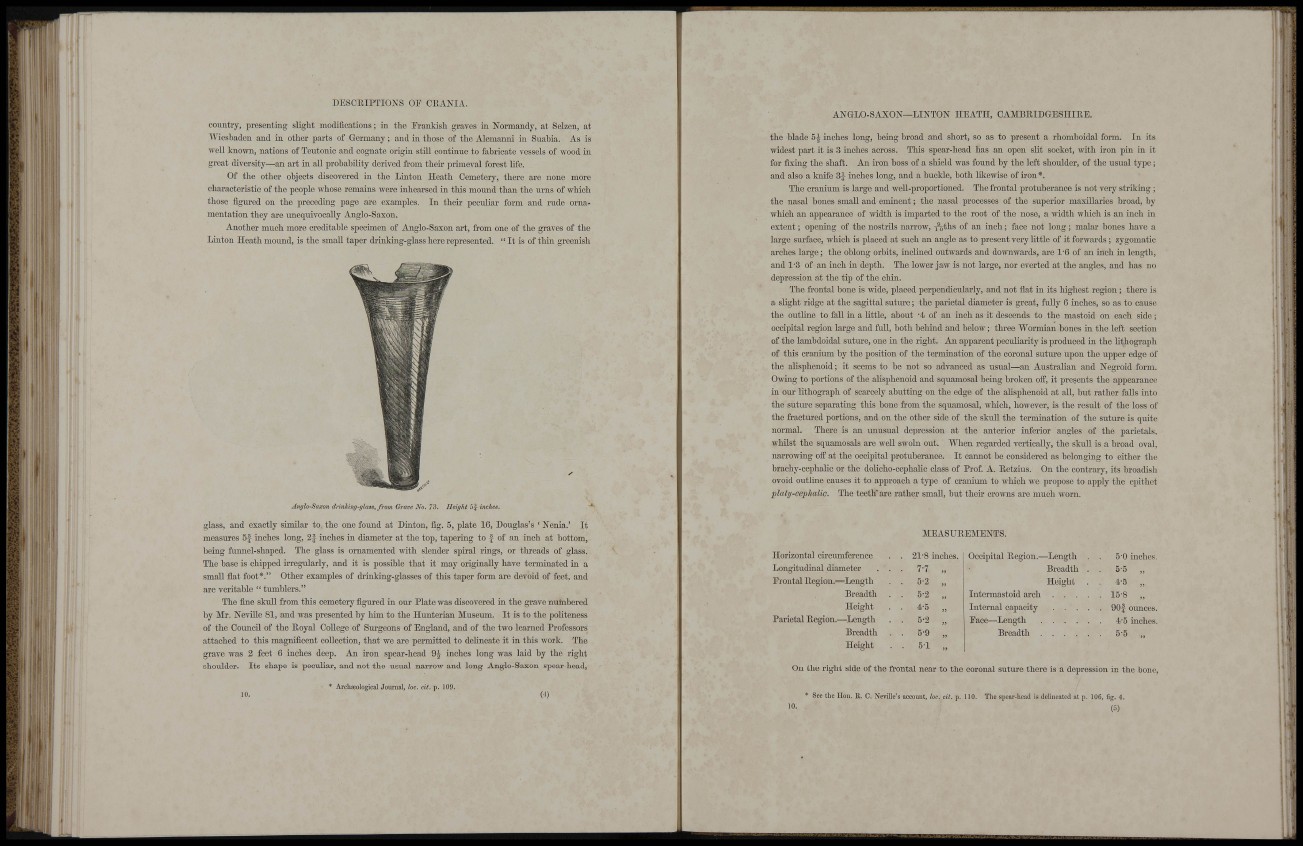
,1 liCIII
¡li ill!
I'm
: I I.
' li,
! ,
PI
M • I
(k
DESCRIPTION 8 OP CRANIA.
country, presenting sUglit modifications; in tlie PranMsh graves in Normandy, at Selzen, at
Wiesbaden and in other parts of Germany ; and in those of tlie Alemanni in Suahia. As is
\reU knoTO, nations of Teutonic and cognate origin still continue to fabricate vessels of wood in
great diversity—an art in all probability derived from their primeval forest life.
Of the other objects discovered in the Linton Heath Cemetery, there are none more
characteristic of the people whose remains were inhearsed in this moimd than the urns of which
those figured on the preceding page are examples. In their peculiar form and rude ornamentation
they are unequivocally Anglo-Saxon.
xinother much more creditable specimen of Anglo-Saxon art, from one of the graves of the
Linton Heath mound, is the smaU taper drinking-glass here represented. " It is of thin greenish
Anglo-Saxon drinking-glass, from Grave No. Height inches. '*
glass, and exactly similar to, the one found at Dinton, fig. 5, plate 16, Douglas's ' Nenia.' It
measures 5f inches long, 2f inches in diameter at the top, tapering to f of an inch at bottom,
being funnel-shaped. The glass is ornamented with slender spiral rings, or threads of glass.
The base is chipped irregularly, and it is possible that it may originally have terminated in a
small flat foot*." Other examples of drinking-glasses of this taper form are devoid of feet, and
are veritable " tiimblers."
The iine skull from this cemetery figured in our Plate was discovered in the grave nutnbered
by Mr. NeviRe 81, and was presented by bim to the Hunterian Museum. It is to the politeness
of the Council of the Royal CoRege of Surgeons of England, and of the two learned Professors
attached to this magnificent collection, that we are permitted to delineate it in this work. The
grave was 2 feet 6 inches deep. An iron spear-head inches long was laid by the right
shoulder. Its shape is peculiar, and not the usual narrow and long Anglo-Saxon spear-hcad.
10.
* Archaeological Journal, loc. cit. p. 109.
(4)
I I
ANGLO-SAXON—LINTON HEATH, CAMBRIDGESHIRE.
the blade inches long, being broad and short, so as to present a rhomboidal form. In its
widest part it is 3 indies across. This spear-head has an open slit socket, with iron pin in it
for fixing the shaft. An ii-on boss of a shield was found by the left shoulder, of the usual type;
and also a knife 3J inches long, and a buckle, both likewise of iron*.
The cranium is large and weR-proportioned. The frontal protuberance is not very striking ;
the nasal bones smaU and eminent; the nasal processes of the superior maxiRaries broad, by
which an appearance of width is imparted to the root of the nose, a width which is an inch in
extent; opening of the nostrUs narrow, i%ths of an inch; face not long; malar bones have a
large surface, which is placed at such an angle as to present very little of it forwards; zygomatic
arches large; the oblong orbits, incUned outwards and downwards, are 1"6 of an inch in length,
and 1-3 of an inch in depth. The lower jaw is not large, nor everted at the angles, and has no
depression at the tip of the chin.
The frontal bone is wide, placed perpendicularly, and not flat in its highest region; there is
a slight ridge at the sagittal sutm'e; the parietal diameter is great, fuRy 6 inches, so as to cause
the outUne to faR in a Uttle, about -4 of an inch as it descends to the mastoid on each side;
occipital region large and fuR, both behind and below; three Wormian bones in the left section
of the lambdoidal suture, one in the right. An apparent peculiarity is produced in the Rthograph
of this cranium by the position of the termination of the coronal suture upon the upper edge of
the alisphenoid; it seems to be not so advanced as usual—an Austrahan and Negroid form.
Owing to portions of the aRsphenoid and squamosal being broken off, it presents the appearance
in our Rthograph of scarcely abutting on the edge of the alisphenoid at aU, but rather faRs into
the sutiu-e separating this bone from the squamosal, which, however, is the result of the loss of
the fractured portions, and on the other side of the skuR the termination of the suture is quite
normal. There is an imusual depression at the anterior inferior angles of the parietals,
whilst the squamosals are weU swoln out. When regarded vertically, the skull is a broad oval,
narrowing oif at the occipital protuberance. It cannot be considered as belonging to either the
brachy-cephalic or the dohcho-cephaRc class of Prof A. Eetzius. On the contrary, its broadish
ovoid outline causes it to approach a type of cranium to which we propose to apply the epithet
platy-cephalic. The teeth'are rather small, but their crowns are much worn.
MEASUREMENTS.
.11,
Horizontal circumference . 21-8 inches. Occipital Region.--Length . 5 0 inches.
Longitudinal diameter . . . 7-7 >3 Breadth . • 5-5 „
Erontal Region.—Length . 5-2 >) Height . • 4-5 „
Breadth . . B-2 3) Intermastoid arch . 15-8 „ ! H
Height . 4-5 3) Internal capacity . 90f ounces.
Parietal Region.—Length . 5-2 ,, Eace—Length 4-5 inches. • 1
Breadth . . 5-9 SJ Breadth • 5-5 „
• 1T :,:
Height . 51 J»
\
On the right side of the frontal near to the coronal suture there is a depression in the bone.
10.
Sec the Hon, R. C. Neville's account, loc. cit. p. 110. The spear-head is delineated at p. 106, fig. 4.
(5)